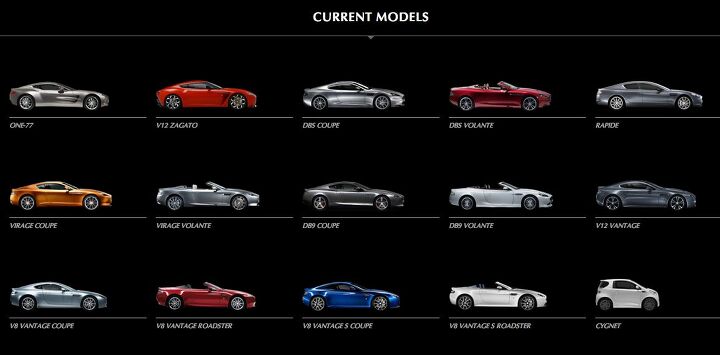Ask The Best And Brightest: Is Aston-Martin A Bit Old Hat?
Ian Callum, designer of the Aston-Martin DB7 (along with the new Jaguars and numerous other gorgeous things) is a really, genuinely nice guy. But even nice guys have their limits, and having seen his groundbreaking Aston design evolve with the morphological dynamism of a sturgeon over the last 17 years, Callum appears to have reached his. Bloomberg reports:
It’s still that same old basic design,” Ian McCallum, who designed the DB9 and is now design director at Tata Motors Ltd. (TTMT)’s Jaguar Land Rover unit, said in a July 27 interview. “Some will argue that if it ain’t broke, don’t fix it. But you do get to a time when you have to move on.”
Sadly, there are a few factual distractions to deal with here before we dig further into Aston’s predicament. First of all, though a Scot, the man’s name is Callum, not McCallum. Also, it’s not clear how much of the DB9 was styled by Callum, and how much was finished by his successor, Heinrik Fisker. Clear? OK, back to Aston…
The models are starting to have a slight whiff of Sunday dinner being used in sandwiches later in the week. It leaves the impression of a company stretching itself as far as it can. In the industry that they operate in, with their competitors, they really need to be cutting edge.
The stuck-in-time, across-the-line styling is part of the problem. A platform that was the talk of the enthusiast committee in 2003 is the other part. A resurgent, Callum-designed Jaguar lineup doesn’t help. Plus, split-the-difference “new” models certainly don’t mask the scent of death well, nor do Toyota rebadges. The prosecution rests.
And what of the defense? Well, all Astons may look the same and be technologically outdated, but they’re still pretty damn good looking. Also,
“All the projects that we are doing have to make a profit,” Chief Executive Officer Ulrich Bez, 66, told journalists at the company’s Gaydon headquarters. “We can’t afford a project that is just a marketing tool.”
The strategy has pushed up the average price of Aston Martin cars 49 percent to 104,000 pounds last year from 70,000 pounds in 2007, the company said at the July 6 briefing.
By recycling technology and using engines from Ford, Aston Martin can keep costs and development times down. That’s secured Aston Martin a profit margin of about 20 percent, nearly double Mercedes’s 10.7 percent return on sales in the second quarter.
Twice the profit margin of Mercedes? That’s nice, but how long will it last when
Daimler AG (DAI), the parent of Mercedes-Benz, plans to spend about 5 billion euros ($7.1 billion) this year on research and development. That’s more than eight times the Gaydon, England-based company’s revenue of 509 million pounds ($830 million) for the 12 months ended March 31.[?]
The sad irony of Aston’s flirtation with over-the-hill, passé status is that it still hasn’t held an IPO, but is waiting for “the right window” (i.e. when the market comes back). By the time that happens, could it be too late for the last independent global British sportscar brand?
More by Edward Niedermeyer
Latest Car Reviews
Read moreLatest Product Reviews
Read moreRecent Comments
- Bkojote Allright, actual person who knows trucks here, the article gets it a bit wrong.First off, the Maverick is not at all comparable to a Tacoma just because they're both Hybrids. Or lemme be blunt, the butch-est non-hybrid Maverick Tremor is suitable for 2/10 difficulty trails, a Trailhunter is for about 5/10 or maybe 6/10, just about the upper end of any stock vehicle you're buying from the factory. Aside from a Sasquatch Bronco or Rubicon Jeep Wrangler you're looking at something you're towing back if you want more capability (or perhaps something you /wish/ you were towing back.)Now, where the real world difference should play out is on the trail, where a lot of low speed crawling usually saps efficiency, especially when loaded to the gills. Real world MPG from a 4Runner is about 12-13mpg, So if this loaded-with-overlander-catalog Trailhunter is still pulling in the 20's - or even 18-19, that's a massive improvement.
- Lou_BC "That’s expensive for a midsize pickup" All of the "offroad" midsize trucks fall in that 65k USD range. The ZR2 is probably the cheapest ( without Bison option).
- Lou_BC There are a few in my town. They come out on sunny days. I'd rather spend $29k on a square body Chevy
- Lou_BC I had a 2010 Ford F150 and 2010 Toyota Sienna. The F150 went through 3 sets of brakes and Sienna 2 sets. Similar mileage and 10 year span.4 sets tires on F150. Truck needed a set of rear shocks and front axle seals. The solenoid in the T-case was replaced under warranty. I replaced a "blend door motor" on heater. Sienna needed a water pump and heater blower both on warranty. One TSB then recall on spare tire cable. Has a limp mode due to an engine sensor failure. At 11 years old I had to replace clutch pack in rear diff F150. My ZR2 diesel at 55,000 km. Needs new tires. Duratrac's worn and chewed up. Needed front end alignment (1st time ever on any truck I've owned).Rear brakes worn out. Left pads were to metal. Chevy rear brakes don't like offroad. Weird "inside out" dents in a few spots rear fenders. Typically GM can't really build an offroad truck issue. They won't warranty. Has fender-well liners. Tore off one rear shock protector. Was cheaper to order from GM warehouse through parts supplier than through Chevy dealer. Lots of squeaks and rattles. Infotainment has crashed a few times. Seat heater modual was on recall. One of those post sale retrofit.Local dealer is horrific. If my son can't service or repair it, I'll drive 120 km to the next town. 1st and last Chevy. Love the drivetrain and suspension. Fit and finish mediocre. Dealer sucks.
- MaintenanceCosts You expect everything on Amazon and eBay to be fake, but it's a shame to see fake stuff on Summit Racing. Glad they pulled it.


































Comments
Join the conversation
The DB9 and V8 vantage are sculpture with a soundtrack. I can see why they're doing what they're doing, after all how many 911 variants are there? It is as close to my perfect vehicle as exists (I use the nav on my phone anyways).
Yeah, Callum was heavily involved with the DB7, but it is grossly unfair to Keith Helfet to suggest that it was Callum's design. http://www.aronline.co.uk/blogs/2011/07/23/concepts-and-prototypes-jaguar-xj4142/